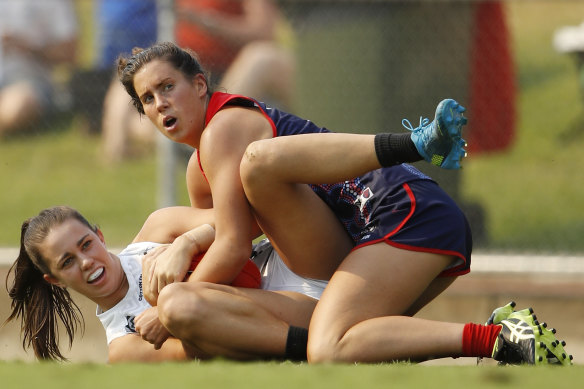Why you’ll see better footy in season seven of AFLW
In 2017, AFLW players lived with the brutal reality of a start-up competition. Eight teams played seven games each with the top two going straight into the grand final; the base wage for a player was $8500 for 17 weeks. Each week, players were paid for just nine hours of training. Additional resources were almost nonexistent.
In that first season and in the years since, players were forced to work full-time hours alongside their football careers, just to stay afloat. I can vividly remember rolling into training with my teammates after an eight-hour shift at work, already completely exhausted. Finishing at the club often after 10pm, with three to four hours of training in the books, players would drive home hungry and utterly exhausted all to do it again the next day. Pushing the boundaries of what could be mentally and physically possible in one day was the only choice AFLW footballers had to keep the dream alive.
Libby Birch (pictured laying a tackle on Chloe Molloy) is expecting a higher quality football in season seven of AFLW.Credit:Getty Images
But the landmark collective bargaining agreement in place for season seven is a game changer. It recognises the effort and sacrifice involved in becoming an elite athlete. The average base wage has increased to $46,000; tier one players receive $71,000. But the biggest part of the deal is the number of paid hours players have been allocated to train. Far from the nine hours in season one, we have been allocated 20 hours per week in pre-season and the season proper, and six hours a week in the off-season. It’s a recognition that although the competition only runs for six months each year, it requires a full-time commitment.
Importantly, this new deal isn’t only going to benefit the players. I predict you will see happier, healthier players. And because of that, you’ll see better football on display in season seven. I can see the transition of becoming a full-time athlete is well on its way. This season’s huge leap in the commitment to provide AFLW players with the best working conditions and environment has revitalised us. We are energised by the fact most of our calls to action have been answered by the new CBA. The initial challenges of a short turnaround between seasons six and seven have been overtaken by excitement and a sense of fulfilment among the playing group.
There is no doubt that these changes will make a tremendous difference on and off the field. I predict you will see happier, healthier athletes and, therefore, better football on display in season seven. The stretch and strain on players is significantly reduced. Yes, we will always be looking for more growth in our great game, but as a player, I can see the transition of becoming a full-time athlete is well on its way. This season’s huge leap in the commitment to provide AFLW players with the best working conditions and environment has revitalised us. We are energised by the fact most of our calls to action have been answered by the new CBA. The initial challenges of a short turnaround between seasons six and seven have been overtaken by excitement and a sense of fulfilment among the playing group.
The competition is now providing more financial stability, enabling players to cut back other work and have more balance in their lives. Clubs can now allocate some daytime training sessions, allowing players more flexibility during their working weeks and limiting the number of late nights. There is more budget allocated to support high-performance staff, giving more opportunity for players to be supported in all levels of their development.
Players are more accountable; clubs can raise their expectations. The extra time on the training track is bringing better skills, an increase in fitness and a higher-performing environment. The additional hours mean players can stay at the club to watch training footage, complete extra sessions, spend more time with coaches and see physios and doctors more regularly after hours.
Most importantly, we can spend more time with each other. There is no doubt in the past two years the pandemic brought the lack of flexibility and the toll of part-time contracts into sharper focus. Football became a transaction. You were in and out of the club not only because of the limited hours allocated on those contracts, but because the risk of getting and or spreading COVID-19 was too high.
Our upcoming season will, for the first time, have 18 teams competing for the premiership – a historic moment for our game and an acknowledgement of how far we have come.
The first national advertisement campaign for AFLW – back in 2017 – highlighted the skills of the athletes and carried the bold tag line “I’d like to see that”. Six seasons later, we are going to see more and better footy from a dedicated and supported group of elite athletes.
Keep up to date with the best AFL coverage in the country. Sign up for the Real Footy newsletter.
Most Viewed in Sport
From our partners
Source: Read Full Article

